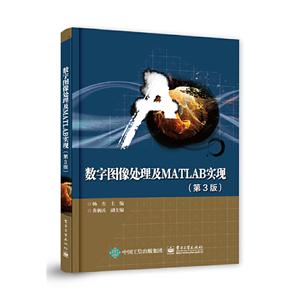-
>
闖進數學世界――探秘歷史名題
-
>
中醫基礎理論
-
>
當代中國政府與政治(新編21世紀公共管理系列教材)
-
>
高校軍事課教程
-
>
思想道德與法治(2021年版)
-
>
毛澤東思想和中國特色社會主義理論體系概論(2021年版)
-
>
中醫內科學·全國中醫藥行業高等教育“十四五”規劃教材
數字圖像處理及MATLAB實現(第3版)/楊杰 版權信息
- ISBN:9787121372599
- 條形碼:9787121372599 ; 978-7-121-37259-9
- 裝幀:平塑
- 冊數:暫無
- 重量:暫無
- 所屬分類:>>
數字圖像處理及MATLAB實現(第3版)/楊杰 本書特色
本書是在2010年出版的教材基礎上做了修改、補充和完善。書中主要介紹了數字圖像處理的基礎知識、基本方法、程序實現和典型實踐應用。全書分3部分共10章。第1部分(第1~4章)介紹數字圖像處理的基礎知識;第2部分(第5~8章)介紹數字圖像處理的各種技術;第3部分(第9~10章)介紹數字圖像處理的擴展內容。在每章的內容安排上,都是從介紹問題的背景開始,接著講述基本內容和方法,然后介紹實踐應用(通過MATLAB軟件編程),*后進行結果分析。本書內容系統性強,重點突出,理論、應用與實際編程緊密結合,理論與實例并重,同時也能滿足雙語教學的部分要求和對本課程的專業英語詞匯的學習。
數字圖像處理及MATLAB實現(第3版)/楊杰 內容簡介
本書是在2010年出版的教材基礎上做了修改、補充和完善。書中主要介紹了數字圖像處理的基礎知識、基本方法、程序實現和典型實踐應用。全書分3部分共10章。部分(~4章)介紹數字圖像處理的基礎知識;第2部分(第5~8章)介紹數字圖像處理的各種技術;第3部分(第9~10章)介紹數字圖像處理的擴展內容。在每章的內容安排上,都是從介紹問題的背景開始,接著講述基本內容和方法,然后介紹實踐應用(通過MATLAB軟件編程),很后進行結果分析。本書內容系統性強,重點突出,理論、應用與實際編程緊密結合,理論與實例并重,同時也能滿足雙語教學的部分要求和對本課程的專業英語詞匯的學習。
數字圖像處理及MATLAB實現(第3版)/楊杰 目錄
**部分 圖像處理基礎
第1章 概述(Introduction) 1
1.1 數字圖像處理及特點(Characteristics and Processing of Digital Image) 1
1.1.1 數字圖像與數字圖像處理(Digital Images and Digital Image Processing) 1
1.1.2 數字圖像處理的特點(Characteristics of Digital Image Processing) 2
1.2 數字圖像處理系統(System of Digital Image Processing) 3
1.2.1 數字圖像處理系統的結構(Structure of Digital Image Processing System) 3
1.2.2 數字圖像處理的優點(Advantages of Digital Image Processing) 4
1.3 數字圖像處理的主要研究內容(Research Content in Digital Image Processing) 5
1.4 數字圖像處理的應用和發展(Applications and Development of Digital Image Processing)
6
1.4.1 數字圖像處理的應用(Applications of Digital Image Processing) 6
1.4.2 數字圖像處理領域的發展動向(Future Direction in the Field of
Digital Image Processing) 11
1.5 全書內容簡介(Brief Introduction of This Book) 11
小結(Summary) 12
習題(Exercises) 13
第2章 數字圖像處理的基礎(Basics of Digital Image Processing) 14
2.1 人類的視覺感知系統(Visual System of Human Beings) 14
2.1.1 視覺系統的基本構造(Basic Structure of Visual System) 14
2.1.2 亮度適應和鑒別(Intensity Adaption and Identification) 16
2.2 數字圖像的基礎知識(Basics of Digital Image) 19
2.2.1 圖像的數字化及表達(Image Digitalization and Representation) 19
2.2.2 圖像的獲取(Image Acquisition) 20
2.2.3 像素間的基本關系(Basic Relationships between Pixels) 23
2.2.4 圖像的分類(Image Classification) 25
小結(Summary) 29
習題(Exercises) 29
第3章 圖像基本運算(Basic Operation in Digital Image Processing) 30
3.1 概述(Introduction) 30
3.2 點運算(Point Operation) 30
3.2.1 線性點運算(Linear Point Operation) 31
3.2.2 非線性點運算(Non-Linear Point Operation) 32
3.3 代數運算與邏輯運算(Algebra and Logical Operation) 34
3.3.1 加法運算(Addition) 34
3.3.2 減法運算(Subtraction) 36
3.3.3 乘法運算(Multiplication) 37
3.3.4 除法運算(Division) 38
3.3.5 邏輯運算(Logical Operation) 39
3.4 幾何運算(Geometric Operation) 39
3.4.1 圖像的平移(Image Translation) 40
3.4.2 圖像的鏡像(Image Mirror) 41
3.4.3 圖像的旋轉(Image Rotation) 43
3.4.4 圖像的縮放(Image Zoom) 44
3.4.5 灰度重采樣(Gray Resampling) 47
小結(Summary) 50
習題(Exercises) 50
第4章 圖像變換(Image Transform) 51
4.1 連續傅里葉變換(Continuous Fourier Transform) 51
4.2 離散傅里葉變換(Discrete Fourier Transform) 52
4.3 快速傅里葉變換(Fast Fourier Transform) 53
4.4 傅里葉變換的性質(Properties of Fourier Transform) 55
4.4.1 可分離性(Separability) 55
4.4.2 平移性質(Translation) 56
4.4.3 周期性和共軛對稱性(Periodicity and Conjugate Symmetry) 58
4.4.4 旋轉性質(Rotation) 59
4.4.5 分配律(Distribution Law) 59
4.4.6 尺度變換(Scaling) 60
4.4.7 平均值(Average Value) 61
4.4.8 卷積定理(Convolution Theorem) 62
4.5 圖像傅里葉變換實例(Examples of Image Fourier Transform) 62
4.6 其他離散變換(Other Discrete Transform) 65
4.6.1 離散余弦變換(Discrete Cosine Transform) 65
4.6.2 二維離散沃爾什—哈達瑪變換(Walsh-Hadamard Transform) 68
4.6.3 卡胡楠—列夫變換(Kahunen-Loeve Transform) 72
小結(Summary) 73
習題(Exercises) 74
第二部分 圖像處理技術
第5章 圖像增強(Image Enhancement) 75
5.1 圖像增強的概念和分類(Concepts and Categories of Image Enhancement) 75
5.2 空間域圖像增強(Image Enhancement in the Spatial Domain) 76
5.2.1 基于灰度變換的圖像增強(Image Enhancement based on Gray Levels) 76
5.2.2 基于直方圖處理的圖像增強(Image Enhancement based on Histogram Processing)
79
5.2.3 空間域濾波增強(Spatial Filtering Enhancement) 84
5.3 頻率域圖像增強(Image Enhancement in the Frequency Domain) 91
5.3.1 頻率域增圖像強基本理論(Fundamentals of Image Enhancement
in the Frequency Domain) 91
5.3.2 頻率域平滑濾波器(Frequency Smoothing Filters) 92
5.3.3 頻率域銳化濾波器(Frequency Sharpening Filters) 95
5.3.4 同態濾波器(Homomorphic Filters) 97
小結(Summary) 99
習題(Exercises) 99
第6章 圖像復原(Image Restoration) 101
6.1 圖像復原及退化模型基礎(Fundamentals of Image Restoration and
Degradation Model) 101
6.1.1 圖像退化的原因及退化模型(Causes of Image Degradation and
Degradation Model) 102
6.1.2 圖像退化的數學模型(Mathematic Model of Image Degradation) 104
6.1.3 復原技術的概念及分類(Concepts and Categories of Restoration) 105
6.2 噪聲模型(Noise Models) 106
6.2.1 一些重要噪聲的概率密度函數(Some Important Noise Probability
Density Functions) 106
6.2.2 噪聲參數的估計(Estimation of Noise Parameters) 109
6.3 空間域濾波復原(Restoration with Spatial Filtering) 110
6.3.1 均值濾波器(Mean Filters) 110
6.3.2 順序統計濾波器(Order-Statistics Filters) 113
6.4 頻率域濾波復原(Restoration with Frequency Domain Filtering) 116
6.4.1 帶阻濾波器(Bandreject Filters) 117
6.4.2 帶通濾波器(Bandpass Filters) 119
6.4.3 其他頻率域濾波器(Other Filters in Frequency Domain) 119
6.5 估計退化函數(Estimating the Degradation Function) 121
6.5.1 圖像觀察估計法(Estimation by Image Observation) 121
6.5.2 試驗估計法(Estimation by Experimentation) 121
6.5.3 模型估計法(Estimation by Modeling) 122
6.6 逆濾波(Inverse Filtering) 124
6.7 *小均方誤差濾波——維納濾波(Minimum Mean Square Error Filtering-
Wiener Filtering) 125
6.8 幾何失真校正(Geometric Distortion Correction) 128
6.8.1 空間變換(Spatial Transformation) 129
6.8.2 灰度插值(Gray-Level Interpolation) 131
6.8.3 實現(Implementation) 131
小結(Summary) 134
習題(Exercises) 134
第7章 圖像壓縮編碼(Image Compression Coding Technology) 136
7.1 概述(Introduction) 136
7.1.1 圖像的信息量與信息熵(Information Content and Entropy) 136
7.1.2 圖像數據冗余(Image Data Redundancy) 138
7.1.3 圖像壓縮編碼方法(Coding Methods of Image Compression) 140
7.1.4 圖像壓縮技術的性能指標(Evaluation Index of Image Compression Approaches)
140
7.1.5 保真度準則(Fidelity Criteria) 142
7.2 無失真圖像壓縮編碼(Lossless Image Compression) 143
7.2.1 哈夫曼編碼(Huffman Coding) 143
7.2.2 游程編碼(Run-Length Coding) 145
7.2.3 算術編碼(Arithmetic Coding) 148
7.3 有限失真圖像壓縮編碼(Lossy Image Compression) 150
7.3.1 率失真函數(Rate Distortion Function) 151
7.3.2 預測編碼和變換編碼(Prediction Coding and Transform Coding) 152
7.3.3 矢量量化編碼(Vector Quantification Coding) 160
7.4 圖像編碼新技術(New Image Coding Technology) 162
7.4.1 子帶編碼(Subband Coding) 162
7.4.2 模型基編碼(Model-Based Coding) 163
7.4.3 分形編碼(Fractal Coding) 164
7.5 圖像壓縮技術標準(Image Compression Standards) 164
7.5.1 概述(Introduction) 164
7.5.2 JPEG壓縮(JPEG Compression) 165
7.5.3 JPEG 2000 166
7.5.4 H.26x標準(H.26x Standards) 168
7.5.5 MPEG標準(MPEG Standards) 168
小結(Summary) 169
習題(Exercises) 170
第8章 圖像分割(Image Segmentation) 171
8.1 概述(Introduction) 171
8.2 邊緣檢測和連接(Edge Detection and Connection) 173
8.2.1 邊緣檢測(Edge Detection) 173
8.2.2 邊緣連接(Edge Connection) 181
8.3 閾值分割(Image Segmentation using Threshold) 184
8.3.1 基礎(Foundation) 184
8.3.2 全局閾值(Global Threshold) 185
8.3.3 自適應閾值(Adaptive Threshold) 190
8.3.4 *佳閾值的選擇(Optimal Threshold) 190
8.3.5 分水嶺算法(Watershed Algorithm) 191
8.4 區域分割(Region Segmentation) 193
8.4.1 區域生長法(Region Growing) 193
8.4.2 區域分裂合并法(Region Splitting and Merging) 196
8.5 二值圖8
數字圖像處理及MATLAB實現(第3版)/楊杰 作者簡介
楊杰,武漢理工大學信息工程學院教授,博士生導師。主要研究方向為:信息傳輸理論及應用,數字圖像處理及模式識別。主講本科生數字圖像處理,模式識別,專業導論等課程;主講碩士研究生模式識別,數字圖像處理與分析,信息隱藏技術課程;主講博士生信息傳輸理論及計算機視覺課程。
- >
自卑與超越
- >
有舍有得是人生
- >
龍榆生:詞曲概論/大家小書
- >
名家帶你讀魯迅:朝花夕拾
- >
企鵝口袋書系列·偉大的思想20:論自然選擇(英漢雙語)
- >
姑媽的寶刀
- >
山海經
- >
回憶愛瑪儂
















